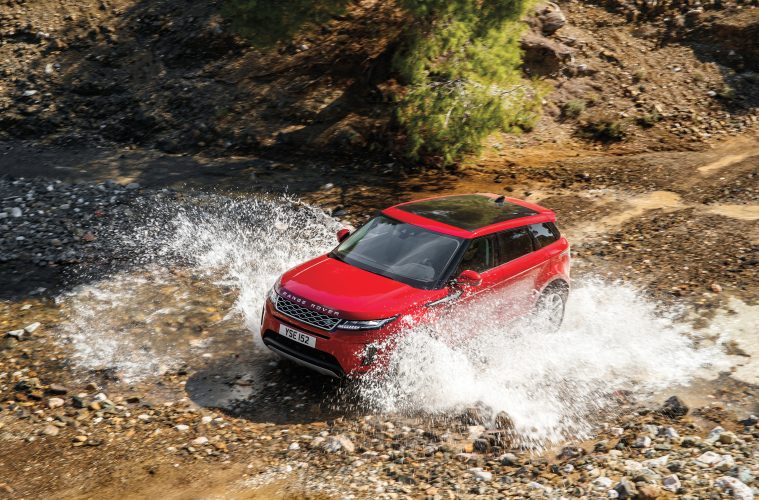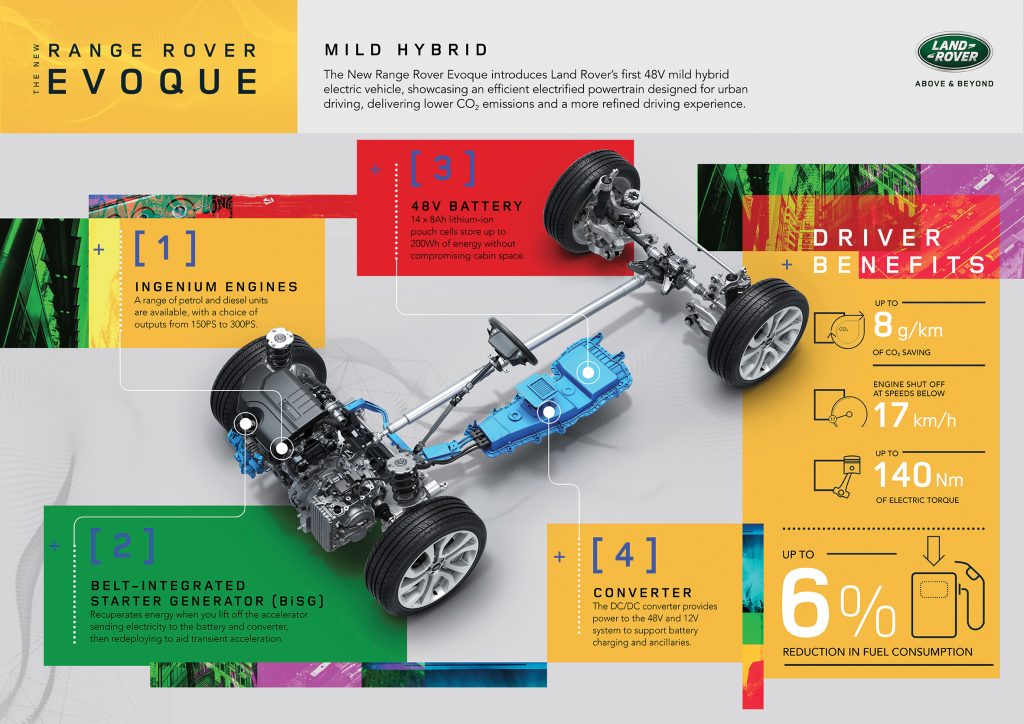When the Discovery came into the US lineup in 1994, I visited a Land Rover dealer in Houston, TX. A sales guide told me that the inclusion of the Discovery dismayed her, as it would “bring in a different kind of customer” than the Range Rover and Defender enthusiasts who had made her life so easy. After all, demand exceeded supply of those low-volume models.
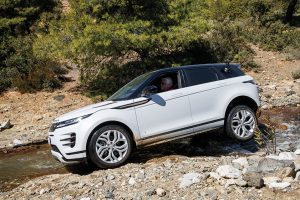 However, Land Rover needed the volume sales of the Discovery worldwide to provide it with the funds necessary for future development of other models. The Discovery brought the qualities and capabilities of a Land Rover to thousands of owners in North America who sought a vehicle different from a Range Rover or Defender, introducing the marque and making owners into enthusiasts.
However, Land Rover needed the volume sales of the Discovery worldwide to provide it with the funds necessary for future development of other models. The Discovery brought the qualities and capabilities of a Land Rover to thousands of owners in North America who sought a vehicle different from a Range Rover or Defender, introducing the marque and making owners into enthusiasts.
Land Rover introduced the Range Rover Evoque in 2010, and in the process, created a market segment of the smaller, premium SUV, aimed at the more urban driver. Just as with the Range Rover (1970), the Discovery (1989) and the Freelander (1997), the first Evoque brought the Land Rover marque to buyers who had not considered a Land Rover in the past.
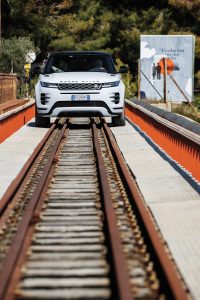 Since its introduction, Land Rover has sold over 772,000 Evoques worldwide. The compact SUV doesn’t get the respect in the US that it does in the rest of the world, as only about 10% of the total sales wind up here. The North American market favors the Range Rover Sport and Range Rover, but worldwide sales of the Evoque have proved critical for Jaguar Land Rover.
Since its introduction, Land Rover has sold over 772,000 Evoques worldwide. The compact SUV doesn’t get the respect in the US that it does in the rest of the world, as only about 10% of the total sales wind up here. The North American market favors the Range Rover Sport and Range Rover, but worldwide sales of the Evoque have proved critical for Jaguar Land Rover.
The second generation Evoque comes to North America as a 2020 model, and it should now receive respect from US enthusiasts. At the Global Launch in Greece last March, it demonstrated that you don’t need to go big to go off-road.
A glance at the new model leaves you thinking that not much has changed, but you’d be wrong. For one thing, this Evoque started on a new monocoque Premium Traverse Architecture — which certainly looked impressive as a body-in-white on display. Aside from a desire for an even stiffer body structure, this new architecture carved out room for MHEV batteries, and hints at future electrification. The PRA also creates a less-than-one-inch stretch of the wheelbase, which results in more rear leg room, bigger storage compartments and an increase in the rear luggage space, a needed-improvement from the previous model.
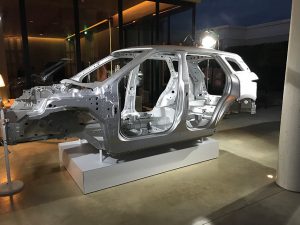 There’s more aluminum and different attachment points for the front and rear suspension. The front McPherson strut suspension is enhanced through Hydrobush fluid-filled bushings, designed to reduce any steering wheel vibration; the rear is an integral link suspension to enhance handling on and off-road, while further reducing cabin noise. An Adaptive Dynamics system of sensors adjusts suspension response as needed every 100 milliseconds.
There’s more aluminum and different attachment points for the front and rear suspension. The front McPherson strut suspension is enhanced through Hydrobush fluid-filled bushings, designed to reduce any steering wheel vibration; the rear is an integral link suspension to enhance handling on and off-road, while further reducing cabin noise. An Adaptive Dynamics system of sensors adjusts suspension response as needed every 100 milliseconds.
Only the four side door hinges are carried over from the first generation Evoque. The exterior hallmarks of the trend-setting original remain: the clamshell hood, floating roof line, rising belt line, and coupe-like shape. Even with a new front end appearance and sharper rear taillights, it remains unique and instantly identifiable. Retractable door handles, first seen on the Range Rover Velar, appear on the new Evoque, too. Lock the doors and/or proceed forward or reverse and they recede into the door. At the moment, the Evoque will come only as a 4-door — no coupe, no convertible.
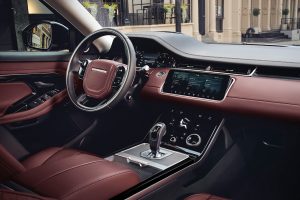 Open the wide door and you’ll be struck by the striking, smooth, “reductive” design of the fascia. An instrument binnacle is easily visible no matter how you adjust the steering wheel. I welcomed the return of a gearshift lever instead of a rotary knob, although I will admit that various safety buttons tripped me up at times. Sport mode engages with a mere move of the lever to the left. I traveled 300 km or so over two days, on-road and off-road, and found the seats supportive and comfortable. Those seats could be covered with a wide range of leathers and sustainable fabrics. I’ll leave the noise/harshness/vibration judgements to drivers whose daily drivers are not Series Land Rovers.
Open the wide door and you’ll be struck by the striking, smooth, “reductive” design of the fascia. An instrument binnacle is easily visible no matter how you adjust the steering wheel. I welcomed the return of a gearshift lever instead of a rotary knob, although I will admit that various safety buttons tripped me up at times. Sport mode engages with a mere move of the lever to the left. I traveled 300 km or so over two days, on-road and off-road, and found the seats supportive and comfortable. Those seats could be covered with a wide range of leathers and sustainable fabrics. I’ll leave the noise/harshness/vibration judgements to drivers whose daily drivers are not Series Land Rovers.
The 2.0L Ingenium engine sits sideways, as before, and produces either 246 hp/269 ft lbs torque or 296 hp /295 ft lbs torque. The US market will see only the 296 hp version, with or without a mild hybrid 48-volt system. (Oddly, our test vehicles were the European 246 hp spec with MHEV.) The MHEV comes into play most effectively when the vehicle senses an impending stop and shuts off the engine. Upon restart, the regenerative capacity of the hybrid system’s starter-generator adds seamless torque to the startup. This minimizes the impact of the stop/start system while improving acceleration from a standing start. The ZF 9-speed transmission remains the same with some changes in calibration for additional smoothness. A Driveline Disconnect feature activates front-wheel drive only, but returns power to all four wheels when sensors dictate the need. At no time could I or my driving partner, Travis Langness of Edmunds, feel any effects from its operation.
To this Series/Discovery I driver, technology features such as connectivity matter less than some genuine enhancements such as ClearSight Ground View, which uses cameras on the grill and door mirrors to show what lies ahead and beneath the front of the Evoque — perfect for steep ascents and water crossings [with an increased wading depth, too.] Press a button on the usual rear view mirror and it becomes a ClearSight rear view mirror, using rear cameras to give you a more panoramic sweep of what’s behind you — handy, when you fill the back of the Evoque such that it blocks the narrow rear window.
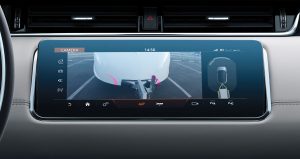 Happily, Land Rover chose Greece as its locale for the Global Launch of the new Evoque. Aside from spectacular scenery, warm sunny days, ancient ruins, storybook villages and mouth-watering cuisine, Greece also made possible a perfect mix of driving conditions: highways, twisting, winding two-lane roads, and superb off-road driving (although we never drove on the snow-capped peaks). We had been warned that one of our drive days would occur on Greek Independence Day, and therefore, the loose rules of the road might loosen further. The Evoque’s size provided some extra stature amongst the smaller European cars on the roads, but what really saved us was the nimble handling, responsive steering (but with less steering feel than I would like) and excellent acceleration, especially in sport mode. Land Rover did not have EPA mileage figures yet, but promises that they will be better than the first generation.
Happily, Land Rover chose Greece as its locale for the Global Launch of the new Evoque. Aside from spectacular scenery, warm sunny days, ancient ruins, storybook villages and mouth-watering cuisine, Greece also made possible a perfect mix of driving conditions: highways, twisting, winding two-lane roads, and superb off-road driving (although we never drove on the snow-capped peaks). We had been warned that one of our drive days would occur on Greek Independence Day, and therefore, the loose rules of the road might loosen further. The Evoque’s size provided some extra stature amongst the smaller European cars on the roads, but what really saved us was the nimble handling, responsive steering (but with less steering feel than I would like) and excellent acceleration, especially in sport mode. Land Rover did not have EPA mileage figures yet, but promises that they will be better than the first generation.
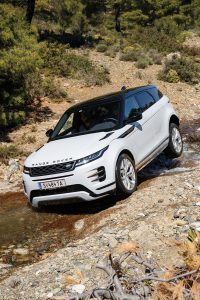 Off-road, the Evoque genuinely surprised me. While the ascent, departure and breakover angles are slightly less than the previous model, the ground clearance and wading depth have improved. Land Rover Experience instructors suddenly appeared in unexpected locations to show off the Evoque’s greater overall capabilities. One sequence took us through a river bed to tread water, but the dry weather had lowered the water level substantially.
Off-road, the Evoque genuinely surprised me. While the ascent, departure and breakover angles are slightly less than the previous model, the ground clearance and wading depth have improved. Land Rover Experience instructors suddenly appeared in unexpected locations to show off the Evoque’s greater overall capabilities. One sequence took us through a river bed to tread water, but the dry weather had lowered the water level substantially.
Another took place on a closed-off, rickety train bridge that crossed the famous Corinth Canal. I admit to puzzlement when I saw the instructor wearing straps, ropes and carabiners. He pointed across the wide bridge at another instructor ready to guide me across the bridge. I didn’t understand the purpose of all the ropes until after about 10 feet of travel when the bridge let out a might “crack” and “groan.” At first I though I hit something, but it was just the bridge settling and springing from the weight of the Evoque. After driving across I realized the strap-wielding instructor was there in case he had to rescue a panicked driver. (Land Rover’s Nathan Hoyt explained later that JLR brought over structural engineers to determine the repairs needed before use.)
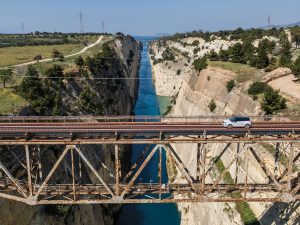 So far, so good — the Evoque’s electronic off-road systems had worked perfectly. The best came as we drove up and down a hilly lane to our hotel on the Peloponnese Peninsula overlooking the Aegean Sea. I’m stopped by an instructor on a 35-degree dirt and rock ascent. I’m staring at the sky. He checks that I’m in the “Mud and Ruts” setting and tells me to push harder on the brake pedal. Sure enough, it sinks a bit and a light on the dashboard reads “HOLD.” When I release the brake, the Evoque does not move. As instructed, to start up the hill I gently press the accelerator, hold it for a few seconds and the Evoque slowly but effortlessly walks its way the rest of the steep incline.
So far, so good — the Evoque’s electronic off-road systems had worked perfectly. The best came as we drove up and down a hilly lane to our hotel on the Peloponnese Peninsula overlooking the Aegean Sea. I’m stopped by an instructor on a 35-degree dirt and rock ascent. I’m staring at the sky. He checks that I’m in the “Mud and Ruts” setting and tells me to push harder on the brake pedal. Sure enough, it sinks a bit and a light on the dashboard reads “HOLD.” When I release the brake, the Evoque does not move. As instructed, to start up the hill I gently press the accelerator, hold it for a few seconds and the Evoque slowly but effortlessly walks its way the rest of the steep incline.
When I get to the top, the trail directions point downward towards a similarly steep angle. Once again, I’m instructed to press hard on the brake pedal, hold for a few seconds, look for the “HOLD” light, and release the brake. The Evoque points downhill and I stare down a very long, steep descent. Lifting my foot off the pedal and the Evoque sits still on the slope. Using the steering wheel paddles [or the center touchscreen] I set the hill descent system on its slowest setting. It’s counterintuitive, but as I press gently on the accelerator, the Evoque starts to move downhill. The electronic sensors will prevent a wheel from slipping by sending power to an appropriate opposite wheel. The enhanced engine/drivetrain braking is greater than I’ve experienced with any mechanical system.
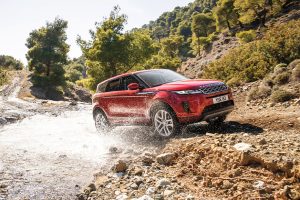 As for quibbles, I offer a few. With its modest front overhang, I’d like to see a lower hood line (or higher seating position) to better sense the front of the Evoque. Similarly, the required airbags in the windshield pillars make them thicker and more obstructive, but that comes with our required safety regulations. In the effort to make the fascia more “reductive,” too many features have migrated to the touchscreens; it would take some time to learn which features appear on which screen. If I’m enjoying the great outdoors off-roading, I’d love a sunroof option. Again, thanks to worldwide safety regulations, it will take some time for Land Rover and tire manufacturers to come up with off-road oriented tires that can come straight from the dealership. With the right tires and some underside protection, the Evoque should be able take you most anywhere; its smaller size will work well on narrow trails or forest lanes.
As for quibbles, I offer a few. With its modest front overhang, I’d like to see a lower hood line (or higher seating position) to better sense the front of the Evoque. Similarly, the required airbags in the windshield pillars make them thicker and more obstructive, but that comes with our required safety regulations. In the effort to make the fascia more “reductive,” too many features have migrated to the touchscreens; it would take some time to learn which features appear on which screen. If I’m enjoying the great outdoors off-roading, I’d love a sunroof option. Again, thanks to worldwide safety regulations, it will take some time for Land Rover and tire manufacturers to come up with off-road oriented tires that can come straight from the dealership. With the right tires and some underside protection, the Evoque should be able take you most anywhere; its smaller size will work well on narrow trails or forest lanes.
The new generation of the Evoque carries the same presence when parked — you recognize it as a Range Rover — with improved road dynamics and surprisingly capable off-road features. It’s time it earned the R-E-S-P-E-C-T here that it’s won deservedly in the rest of the world.
